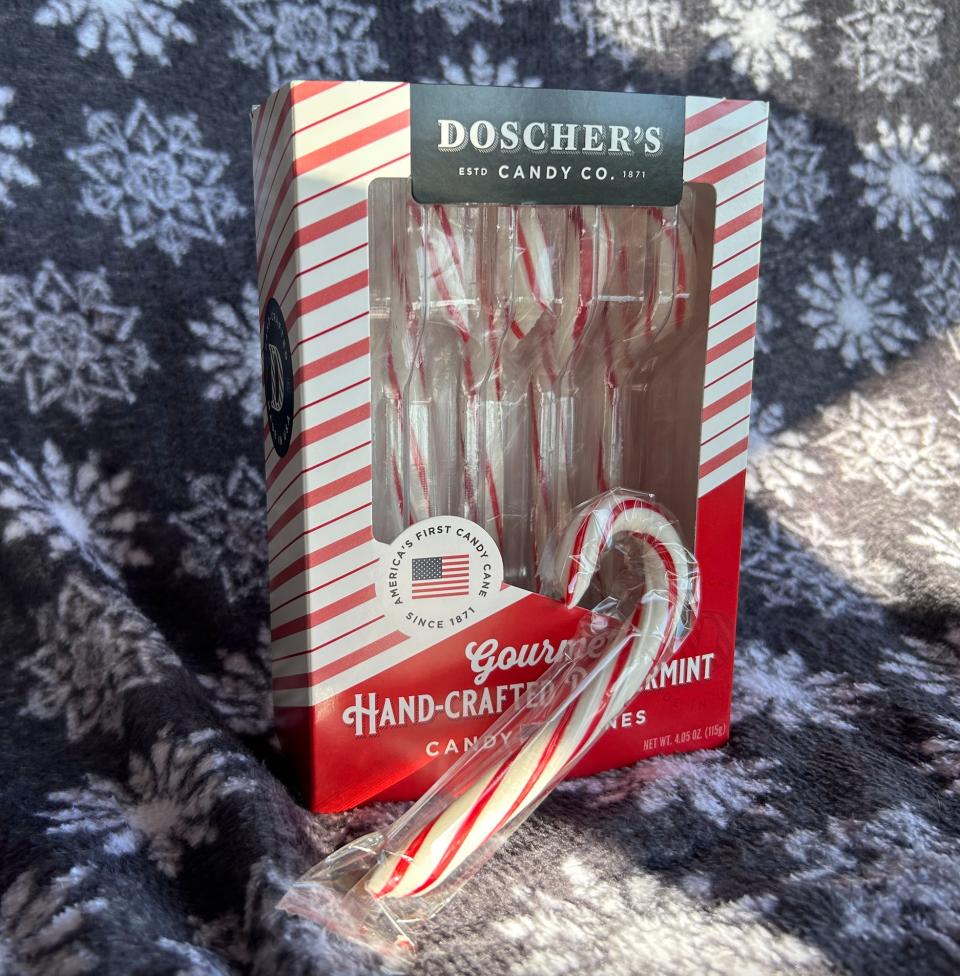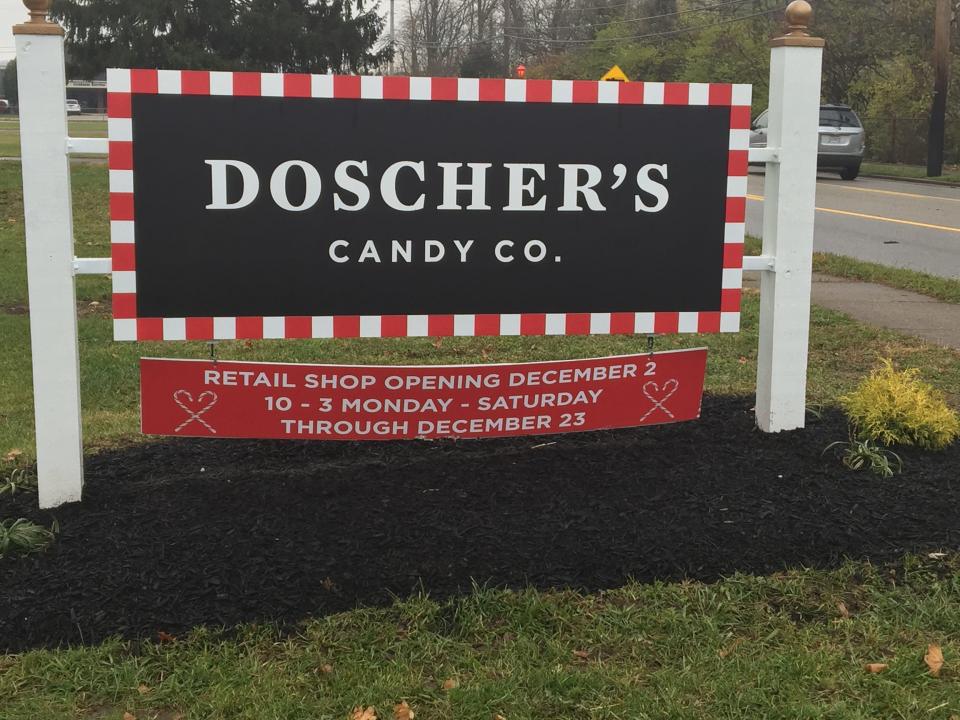No one knows where candy canes came from. But this candy maker perfected the recipe
Red-and-white striped candy canes have been an indelible part of Christmas for ages. From stocking stuffers to decorations, they are one of the most common symbols of the holiday.
In Cincinnati, Doscher’s Candy Co. has been part of the tradition for more than 150 years, making candy canes mostly by hand since 1871. The crunchy yet chewy confections have been a local favorite and a testament to the high quality of handcrafted candy making.
After being located in downtown Cincinnati for 146 years, Doscher’s moved 11 miles east to the village of Newtown in 2017. They settled into the big, yellow McGill House at 6926 Main St., built circa 1835, which has been renovated as a gift shop and coffee house, with the candy-making facilities located in a new red barn behind the house.
Doscher’s has been making candy since 1871
Doscher’s Candy Co. was founded in 1871 by Claus Doescher – with an “e” in his name. He came to Cincinnati from his hometown of Grossenhain, Germany, in 1865 to work with his uncles, Albert and Johann, who had started the A&J Doescher Sugar and Candy Co. at the corner of 12th and Jackson streets in Over-the-Rhine. The uncles specialized in wholesale penny candy.
Claus broke off on his own with a candy-making business at Fifth Street between Broadway and Sycamore. His brothers, John and Henry, soon joined what became Doscher Bros. To avoid confusion with the other candy maker in the family, the brothers changed their names to Doscher, dropping the “e.”

Claus began making candy canes that first year, then more candies followed, including their signature French Chew taffy and Bon Ton chocolates.
Doscher’s opened a store on West Fifth Street and operated a four-story factory on Canal Street (later Central Parkway) for many years before moving everything to West Court Street about 1936. They occupied 24 W. Court St. from 1946 to 2017.
After Claus died in 1883 at age 37, his brothers continued the business. Then Claus’ sons, Harry and John, took over in the 1930s, but both died a few years later. Harry’s wife, Elsie, ran the company until Harry Jr. was old enough. Doscher’s stayed in the family for four generations until they sold the business to Greg Clark in 2005. Chip Nielsen, current president and CEO, and his family became partners in the company in 2015.
How candy canes are made by hand
Doscher’s still makes candy canes the same way Claus Doscher did it in 1871, cooking in copper kettles and kneading the sugar mixture into shape by hand.
In a 1985 Enquirer story, reporter Margaret Josten described Harry Doscher Jr. demonstrating the process:
“Doscher talks very little as he works – for good reason. He is occupied hefting a 100-pound sack of sugar to a giant cooker, where it is mixed with corn syrup and water to start a batch of candy canes. …
“After the sugar, corn syrup and water are cooked and cooled to the proper consistency, Doscher slaps a 90-pound glob of the sweet stuff onto a metal table. There, he and two aides, wearing similar clothing, begin the job of putting the candy canes into final shape.
“One portion of the sugary mass is divided off to be colored red. The much larger portion is given a liberal dose of calcium carbonate to keep the colors from bleeding. Then Doscher places the large portion on a wheel and spins it until it becomes white and translucent.
“Doscher adds the peppermint (oil) during the spinning – and there are no measuring cups in evidence. After all, he has made candy canes thousands of times since he began working part-time at the factory as a child.
“The cane-making process eventually comes down to the point the peppermint-flavored and the red-colored portions of the sugar mixture are fed at the same time into a machine that rolls them together. The hooks are fashioned by hand as thin sticks of striped candy emerge warm from the machine.”
Doscher’s made about 25 batches of candy canes a day for the holiday season.
What is the origin of candy canes?
Did you know candy canes used to be just white?
That’s about all we know for sure about the origins of the Christmas treat. There are many traditions and legends, but little in the way of documentation.
Some say the white represents the purity of the Virgin Mary, the red the blood shed by Christ and the shape is an upside-down “J” for Jesus.
A popular legend has it that back in 1670, a choirmaster at Cologne Cathedral in Germany needed to keep restless children occupied during the long church service. So he gave them white candy sticks, representing the purity of Christ, then had them made into the shape of a shepherd’s crook to remind the children of the shepherds who visited baby Jesus.
While there is no corroborating evidence for either of these stories, there’s also few records of how candy canes really got started.

Candy sticks date back to the 17th century, and were likely made into hook shapes to hang on Christmas trees.
The first use of candy canes in America is credited to August Imgard, a German-Swedish immigrant in Wooster, Ohio, who in 1847, decorated a blue spruce Christmas tree with paper ornaments, kuchen (German cake) and white candy canes.
In print, candy canes first appeared in children’s stories. The short story “Tom Luther’s Stockings” by Mrs. M.A. Bates, appearing in the September 1866 issue of Ballou’s Monthly Magazine, mentioned “mammoth candy canes which were displayed in a shop window.”
In “Benny’s Letter,” appearing in The Nursery magazine in 1874, 6-year-old Benny asks Santa for several items for Christmas, including a “candy-cane.”
With more and more sources being digitized, perhaps additional evidence may crop up.
For instance, most sources agree that the red stripe was not added to candy canes until the early 20th century. The proof? Christmas cards before 1900 show only white candy canes, but striped ones after that date.

Yet, on Dec. 25, 1877, The Enquirer reported, “Billy McHugh, of the Water-Works off-and-on force, was presented with a striped, peppermint candy cane by his admiring fellow-workmen yesterday.”
(Two days later, the story was corrected: “It was Millard T. Thompson, the strawberry blonde, who was presented with the candy cane, not Billy McHugh. Billy is sweet enough without it.”)
Perhaps that candy cane prize came from Doscher’s.
Sources: Enquirer archives, “Cincinnati Candy: A Sweet History” by Dann Woellert, CandyHistory.net, CandyRetailer.com, Smithsonian Magazine, History.com, Wikipedia, Snopes.com, National Geographic
This article originally appeared on Cincinnati Enquirer: Why are candy canes shaped that way? Their origins are iffy

